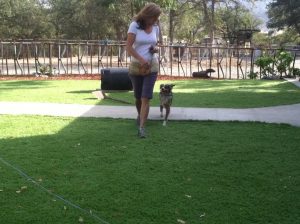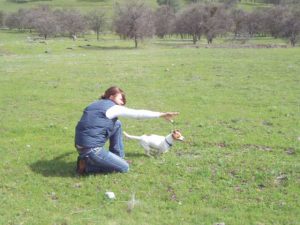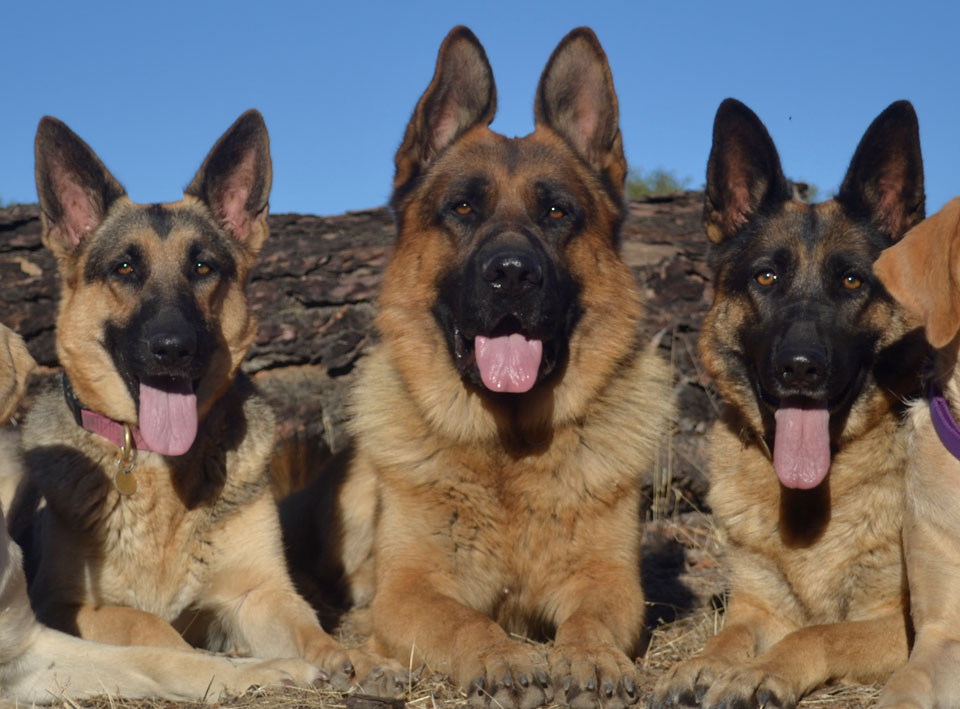Have you ever tried to quit a bad habit? Easy? No! The longer you’ve been doing that unwanted behavior the more triggers there are that set it off. It seems impossible to ever be truly free from that old nasty routine. But, alas, triggers can be broken, and new habits can form! Not only with us humans, but for our pets as well! It just takes a combination of enormous self-control and time.
When I was a smoker, every time I had a cup of coffee, my brain automatically thought of a cigarette. If I was tired and wanted to take a break, again, a cigarette popped into my mind. After I had a meal, getting into a car, talking on the phone, these were all triggers that immediately caused a desire to smoke. But now? The thought of smoking never even enters my mind (unless of course I am giving this lecture to new clients)!
 Your dog’s behavior is the same thing! Even more so, as they react to triggers without even thinking about it. “I see another dog, I hackle, growl and bark. I see a cat, I go for the chase. A friendly person walks up and I jump up to lick them in the face.” These, like most other dog behaviors, are just habits; old responses done automatically because it’s what we have always done. And like us humans, your dog can form new habits, and eventually the old triggers set off a totally new reaction. (One that us humans enjoy!) Any dog, any age, any habit can be broken and replaced with a new one.
Your dog’s behavior is the same thing! Even more so, as they react to triggers without even thinking about it. “I see another dog, I hackle, growl and bark. I see a cat, I go for the chase. A friendly person walks up and I jump up to lick them in the face.” These, like most other dog behaviors, are just habits; old responses done automatically because it’s what we have always done. And like us humans, your dog can form new habits, and eventually the old triggers set off a totally new reaction. (One that us humans enjoy!) Any dog, any age, any habit can be broken and replaced with a new one.
But remember, it takes self control AND time before the response to triggers are changed for good! And this is where you must help. You have to make him or her WANT to change, and you have to consistently reinforce the new, desirable response. Remember, just like sneaking a cigarette while you are trying to quit smoking, if your dog is occasionally allowed to practice the old behavior, it will take much longer to break the bad habit and make a good one. You have all heard it’s important to “be consistent” when training a dog, and this is why it truly is SO IMPORTANT. Your dog needs help to change this habit, it’s tough even if you are the one wanting the change, let alone when someone else is asking you to change for them. So you HAVE to help them, by being consistent.
Okay you think, I can be consistent, but how do I make my dog WANT to change, remember, to break a habit one needs SELF control! So many people are torn between “positive” dog training and “negative” dog training, which tools are “acceptable” and which are not. It’s like this; you can’t build a house without a hammer and nails. But once the house is built, if you still need a hammer and nails every time you go in or out of the house, then you really didn’t build it properly did you?
 The same goes for dog training. Tools are necessary to help break unwanted habits and create new positive ones, but eventually you shouldn’t need those tools if you truly changed the behavior and created a new habit. As mentioned earlier, a habit is just an automatic response to a trigger, something you do without really thinking about it.
The same goes for dog training. Tools are necessary to help break unwanted habits and create new positive ones, but eventually you shouldn’t need those tools if you truly changed the behavior and created a new habit. As mentioned earlier, a habit is just an automatic response to a trigger, something you do without really thinking about it.
A “negative” tool such as a correction from a snap of a leash or nick from an electric collar, makes your dog want to stop the old response. Your dog may not have a problem with barking insanely every time he sees another dog. So the negative correction gets his attention, and is undesirable just enough to make him think first about responding to that trigger. Now he has a reason to really WANT to change.
Once he is thinking, you can use “positive tools” (your love, voice, a treat) to help mold the new reaction that you desire. “Oh…when I see a dog or stray cat, I ignore it. When I want a human’s attention I sit in front of them and look up patiently.”
So how long does it take? Well, the answer is, it depends. Has your dog been practicing this bad habit for years, or is it something that just started recently? How many triggers are there that stimulate this reaction? How consistent will you be to not let him have “just one cigarette?” And, how much time do you have each day to help him practice the new, desired response?
You have to be honest with yourself enough to know when you need to call for help. Any dog, no matter the age, breed or issue can be changed! I’ve turned aggressive dogs that bit anyone who dared to come to close into sweethearts, and dogs paralyzed by fear into calm and confident companions. But those issues take a lot of time, with daily consistency. Other dogs, who just get overly wild on the leash when they see other dogs, or like to jump up on your counters to sneak food, etc. may be transformed in a day, with only reinforcement necessary for a few weeks after that.
 The best advice I can give you, is find an expert in dog behavior reasonably close by, and do a private one on one training session with them. They should be able to teach you in just a lesson or two what needs to be done to break the old habit and create a new one. They should be able to give you a reasonable time frame for accomplishing the necessary changes. If the time and work necessary is something you can honestly commit to then go for it! Petworks has hundreds of certified dog trainers throughout the United States, and you can book one right on their platform. Get occasional help as needed to sharpen your skills as you learn to be a better dog handler. But if the amount of work and time suggested is really more than your work or home schedule will allow, then send him in for a board and train stay, so he can get the daily practice he needs to create that new, positive habit.
The best advice I can give you, is find an expert in dog behavior reasonably close by, and do a private one on one training session with them. They should be able to teach you in just a lesson or two what needs to be done to break the old habit and create a new one. They should be able to give you a reasonable time frame for accomplishing the necessary changes. If the time and work necessary is something you can honestly commit to then go for it! Petworks has hundreds of certified dog trainers throughout the United States, and you can book one right on their platform. Get occasional help as needed to sharpen your skills as you learn to be a better dog handler. But if the amount of work and time suggested is really more than your work or home schedule will allow, then send him in for a board and train stay, so he can get the daily practice he needs to create that new, positive habit.
It may be costly, but so is living with an animal that causes you stress, and a possible lawsuit! Or an animal that you can’t handle, and is a banished to the backyard where he becomes a nuisance; barking, digging or destroying things out of boredom and frustration. Remember, dogs are social, pack animals. They were never meant to be left in isolation. And bizarre, unwanted behaviors are usually the consequence of giving up. So please, be kind to yourself and your pet! Help him create good habits that make him a joy to have around, so he can spend every day being a part of your life and you can truly enjoy his love for the (typically) twelve years or so you have him.
About the Author:

Patricia Varian, of Varian Kennels, has trained dogs for over 30 years, including working at Guide dogs for the blind and competing in AKC and NAHRA events, earning titles on many dogs. She is an evaluator for AKC Canine Good Citizenship, a member of the International Association of Canine Professionals, and her kennel name is registered with AKC. She started using the “Power of the Pack” in the last 20 years, and has 10 well trained/socialized dogs that help her train/rehabilitate other dogs. Most of these are also her top quality AKC breeding dogs! Patricia trains the owners as well as their dogs, giving private and group lessons, as well as creating personal videos of the dogs who come and stay with her to train . Recently Tricia has become more active in the training of Service and Therapy dogs as well as all obedience, behavior and rehabilitation for all companion dogs.


